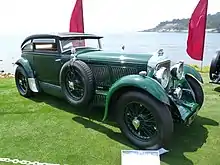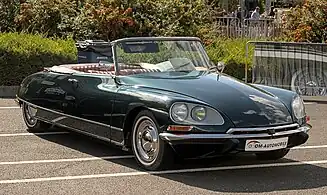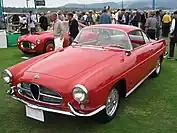
.jpg.webp)

A coachbuilder or body-maker is a person or company who manufactures bodies for passenger-carrying vehicles.[note 1] Coachwork is the body of an automobile, bus, horse-drawn carriage, or railway carriage. The word "coach" was derived from the Hungarian town of Kocs.[1] A vehicle body constructed by a coachbuilder may be called a "coachbuilt body" (British English) or "custom body" (American English).
Prior to the popularization of unibody construction in the 1960s, there were many independent coachbuilders who built bodies on chassis provided by a manufacturer, often for luxury or sports cars. Many manufacturers such as Ferrari outsourced all bodywork to coachbuilders such as Pininfarina and Scaglietti. Coachbuilders also made custom bodies for individual customers. The coachbuilder craftsmen who might once have built bespoke or custom bodies continue to build bodies for short runs of specialized commercial vehicles such as luxury motor coaches or recreational vehicles or motor-home bodied upon a rolling chassis provided by an independent manufacturer. A 'conversion' is built inside an existing vehicle body.
Several renowned automotive coachbuilders, including Pininfarina, Bertone, and Ghia, are based in Italy. In the Italian language, a coachbuilding company is called a carrozzeria.
Horse-drawn origins
.jpg.webp)
A British trade association the Worshipful Company of Coachmakers and Coach Harness Makers was incorporated in 1630. Some British coachmaking firms operating in the 20th century were established even earlier. Rippon was active in the time of Queen Elizabeth I, Barker founded in 1710 by an officer in Queen Anne's Guards. Brewster, the oldest in the U.S., was formed in 1810.[2]
Coach-building had reached a high degree of specialization in Britain by the middle of the 19th century. Separate branches of the trade dealt with the timber, iron, leather, brass and other materials used in their construction. And there were many minor specialists with each of these categories. The “body-makers” produced the body or vehicle itself, while the “carriage-makers” made the stronger timbers beneath and around the body. The timbers used included ash, beech, elm, oak, mahogany, cedar, pine, birch and larch. The tools and processes used were similar to those used in cabinet-making, plus other specific to coach-making. Making the curved woodwork alone called for considerable skill. Making the iron axles, springs and other metal used was the work of the “coach-smith,” one of the most highly paid classes of London workmen.[3] The coating of the interior of the coach with leather and painting, trimming, and decorating the exterior called for specialist tradesmen with a high degree of skill. Building carts and wagons required similar skills, but of a coarser kind.
Automobiles
From the beginning of the automobile industry manufacturers offered complete cars assembled in their own factories commonly using entire bodies made by specialist people using different skills. Soon after the start of the twentieth century mass production coachbuilders developed such as Mulliners or Pressed Steel in Great Britain, Fisher Body, Budd, Briggs in the U. S., or Ambi-Budd in Germany. Many other big businesses remain involved.

Many coachbuilt chassis would come with all lights, standard instruments and their panel, engine cover, mudguards and running boards and spare wheel(s)
Specialist market sector
There remained a market for bodies to fit low production, short-run and luxury cars. Custom or bespoke bodies were made and fitted to another manufacturer's rolling chassis by the craftsmen who had previously built bodies for horse-drawn carriages. Bespoke bodies are made of hand-shaped sheet metal, often aluminum alloy. Pressed or hand-shaped the metal panels were fastened to a wooden frame of particularly light but strong types of wood. Later many of the more important structural features of the bespoke or custom body such as A, B and C pillars were cast alloy components. Some bodies such as those entirely alloy bodies fitted to some Pierce-Arrow cars[4] contained little or no wood, and were mounted on a conventional steel chassis.
_pic1.JPG.webp)
The car manufacturer would offer for sale a chassis frame, drivetrain (consisting of an engine, gearbox, differential, axles, and wheels), brakes, suspension, steering system, lighting system, spare wheel(s), front and rear mudguards (vulnerable and so made of pressed steel for strength and easy repair) and (later) bumpers, scuttle (firewall) and dashboard. The very easily damaged honeycomb radiator, later enclosed and protected by a shell or even reduced to an air intake, was or held the visual element identifying the chassis' brand. To let car manufacturers maintain some level of control over the final product their warranties could be voided if coachbuilders fitted unapproved bodies.
As well as bespoke bodies the same coachbuilders also made short runs of more-or-less identical bodies to the order of dealers or the manufacturer of a chassis. The same body design might then be adjusted to suit different brands of chassis. Examples include Salmons & Sons' Tickford bodies with a patent device to raise or lower a convertible's roof, first used on their 19th-century carriages, or Wingham convertible bodies by Martin Walter.
Obsolescence
Separate coachbuilt bodies became obsolete when vehicle manufacturers found they could no longer meet their customers' demands by relying on a simple separate chassis (on which a custom or bespoke body could be built) mounted on leaf springs on beam axles. Unibody or monocoque combined chassis and body structures became standardised during the middle years of the 20th century to provide the rigidity required by improved suspension systems without incurring the heavy weight, and consequent fuel penalty of a truly rigid separate chassis. The improved more supple suspension systems gave vehicles better road-holding and much improved the ride experienced by passengers.
Ultra-luxury vehicles


Larger car dealers or distributors would commonly preorder stock chassis and the bodies they thought most likely to sell and order them for sale off their showroom floor.
All luxury vehicles during the automobile's Golden Era before World War II were available as chassis only. For example, when Duesenberg introduced their Model J, it was offered as chassis only, for $8,500. Other examples include the Bugatti Type 57, Cadillac V-16, Packard Twelve, Ferrari 250, Isotta Fraschini Tipo 8, Hispano-Suiza J12, and all Rolls-Royces produced before World War II. Delahaye had no in-house coachworks, so all its chassis were bodied by independents, who created their designs on the Type 135. For the Delahaye, most were bodied by Chapron, Labourdette, Franay, Saoutchik, Figoni et Falaschi, or Pennock.
The practice continued after World War II waning dramatically in the 1950s and 1960s. Rolls-Royce debuted its first unibody model, their Silver Shadow, in 1965.
Unibody construction

Independent coachbuilders survived for a time after the mid-20th century, making bodies for the chassis produced by low-production companies such as Rolls-Royce, Ferrari, and Bentley.[5] Producing body dies is extremely expensive (a single door die can run to US$40,000), which is usually only considered practical when large numbers are involved—though that was the path taken by Rolls-Royce and Bentley after 1945 for their own in-house production. Because dies for pressing metal panels are so costly, from the mid 20th century, many vehicles, most notably the Chevrolet Corvette, were clothed with large panels of fiberglass-reinforced resin, which only require inexpensive molds. Glass has since been replaced by more sophisticated materials, if necessary hand-formed. Generally, these replace metal only where weight is of paramount importance.
The advent of unibody construction, where the car body is unified with and structurally integral to the chassis, made custom coachbuilding uneconomic. Many coachbuilders closed down, were bought by manufacturers, or changed their core business to other activities:
- Transforming into dedicated design or styling houses, subcontracting to automotive brands (e.g. Zagato, Frua, Bertone, Pininfarina)
- Transforming into general coachwork series manufacturers, subcontracting to automotive brands (e.g. Karmann, Bertone, Vignale, Pininfarina)
- Manufacturing runs of special coachworks for trucks, delivery vans, touring cars, ambulances, fire engines, public transport vehicles, etc. (e.g., Pennock, Van Hool, Plaxton, Heuliez)
- Becoming technical partners for the development of roof constructions (e.g., Karmann, Heuliez), for example, or producers of various (aftermarket) automotive parts (e.g., Giannini)
Gallery
 Pourtout drophead coupé on a Lancia Belna chassis 1935
Pourtout drophead coupé on a Lancia Belna chassis 1935 Touring 2-seater body on a 1938 Alfa Romeo 6C 2300B chassis
Touring 2-seater body on a 1938 Alfa Romeo 6C 2300B chassis Fixed head coupé by Ghia 1954 on an Alfa Romeo 1900 SS chassis
Fixed head coupé by Ghia 1954 on an Alfa Romeo 1900 SS chassis Hebmüller Cabriolet modifications upon a mass-produced Volkswagen platform chassis
Hebmüller Cabriolet modifications upon a mass-produced Volkswagen platform chassis
List of coachbuilders
Austria
- Ambruster
- Keibl
Belgium
- D'Ieteren
- Grümmer (Bruxelles)
- Simons
- Vanden Plas
- Van Hool
Denmark
- Carsten Jakobsen
France
- Achard, Fontanel & Cie (Lyon)
- Ailloud & Dumond (Lyon)
- Alin & Liautard (Courbevoie)
- Amiot (Dinard, Dinan)
- Angé (Toulouse)
- Ansart & Teisseire (Neuilly)
- Augereau (Brou)
- Autobineau (Neuilly)
- Bail (Paris)
- Baqué (Toulouse)
- Barbier (Cannes)
- Berlioz & Gouillon (Paris)
- Berluteau (Melun)
- Bernin (Tours)
- Besset (Annonay)
- Bigatti (Nice)
- Billeter & Cartier (Lyon)
- Boneberge (Lyon)
- Bonneville & Chabrol (Toulouse)
- Boré (Saint-Lô)
- Candelaresi (Lyon)
- Carrier (Argenteuil, Alençon)
- Chabrol (Toulouse)
- Candelarési (Lyon)
- Carde & fils (Bordeaux)
- Chappe et Gessalin, (Brie-Comte-Robert)
- Chapron (Levallois-Perret)
- Philippe Charbonneaux
- Chatellard (Toulouse)
- Chaussende (Lyon)
- Chausson (Asnières, Gennevilliers)
- Chéreau (Avranches)
- Chicot (Levallois)
- Chilbourg (Paris)
- Clabot (Alfortville)
- Darl'mat (Paris)
- Declerq & Cordonnier (Lille, Roubaix)
- DeCostier (Boulogne s/Seine)
- Decultil & Cie (Lyon)
- Delaroche & Turquet (Le Mans)
- Delaugère (Orléans)
- Deloche (Paris)
- Desouches, David & Cie (Pantin)
- Desvaux (Rueil)
- Di Rosa (La Garenne-Colombes)
- Drouet & Gaucher (Courbevoie)
- Maurice Dumas (Bordeaux)
- Louis Dubos (Neuilly)
- Dubos (Puteaux)
- Duhamel et Compagnie (Paris)
- Duvivier (Levallois-Perret)
- Ehrler (Paris)
- Ehmgard et Delbenque (Paris)
- Esclassan – Tôlerie automobile et industrielle (Boulogne s/Seine)
- Facel-Métallon (Dreux)
- Faget & Varnet (Levallois)
- Faurax (Paris since 1808, later Lyon)
- Faurax & Chaussende (since 1920, Lyon)
- Felber frères (Puteaux)
- Fernandez & Darrin (Paris)
- Figoni et Falaschi (Boulogne s/Seine)
- Firmin (Paris)
- Fleury (Thonon)
- Floquet (Saint-Amand)
- Forrler (Strasbourg)
- Fournier (Bordeaux)
- Fournier (Suresnes)
- Franay (Levallois-Perret)
- Frugier (Toulouse, Limoges)
- Gallé (Boulogne s/Seine)
- Gangloff (Colmar)
- Garros (Toulouse)
- Gaudichet & Turquet (Le Mans)
- Henri Gauthier (Villeurbanne)
- Gilotte (Courbevoie)
- Girardo frères (Cannes)
- Grange frères (Valence-sur-Rhône)
- Gras (Dijon)
- Gruau (Laval)
- Léon Hanovre (Paris)
- Hénon (Albert)
- Henry (Nancy)
- Heuliez (Cerizay)
- Hibbard & Darrin (Paris)
- Jamet (La Guerche, Berry)
- Jeanteaud (Paris)
- Jouan, carrosserie de cuirs (Clichy)
- Jousse & Parsy (Montargis)
- Justrobe (Toulouse)
- Kellner (Paris)
- Kelsch (Levallois)
- Klapper (Toulouse)
- Kraemers fils (Paris)
- Labarre (Evreux)
- Labbé (Lamballe)
- La Carrosserie Industrielle (Courbevoie)
- Lacoste frères (Toulouse)
- Lagache & Glaszmann (Montrouge)
- Lagogué (Alençon)
- Lamplugh & Cie (Levallois-Perret)
- Letourneur et Marchand (Neuilly)
- Le Vieux (Paris)
- Lourtioux (Montluçon)
- Mamy (Besançon)
- Mandement (Toulouse)
- Manessius (Puteaux)
- Maron-Pot (Levallois-Perret)
- Massias (Toulouse)
- Mercier (Toulouse)
- Meulemeester (Clichy)
- Michel (Nice, Marseille)
- Monjardet (Besançon)
- Montel & fils (Marseille)
- Morel (Paris)
- Morin (Parthenay)
- Morin (Rennes)
- Mühlbacher & fils (Puteaux)
- Nicolas (Angoulême)
- Ottin (Lyon)
- Philippe Mühlbacher (Toulouse)
- Pelpel (Noyal s/Vilaine)
- Petitprez & Verschure (Tourcoing)
- Pezet (Toulouse)
- Phaetonia (Courbevoie)
- Plante (Pau)
- Poinsenet (Epernay)
- Pourtout (Rueil-Malmaison)
- Pralavorio Simon (Lyon Montplaisir)
- Privat (Dijon)
- Pruneville (Lyon)
- Radovitch (Reims)
- Rambert & fils (Clermont-Ferrand, Courbevoie)
- Raquin (Montrichard)
- Rasp (Paris)
- Ravistre & Martel (Annonay)
- Repusseau & Cie (Levallois-Perret)
- Rétif (Sancoins, Berry)
- Rheims & Auscher, La Carrosserie Industrielle (Levallois-Perret)
- Rousseau (Montargis)
- Rungette (Levallois-Perret)
- Saoutchik (Neuilly)
- Soulé (Toulouse)
- Spinnewyn (Tourcoing)
- Surirey (Flers)
- Tassé (Pontchâteau)
- Tirbois (Niort)
- Tizot & Viguier (Marseille)
- Tremble (Puteaux)
- Tual (Tredion)
- Vallas (St-Just en Chevalet)
- Van den Bussche (Lille)
- Van den Hende (Roubaix)
- Vanvooren (Courbevoie)
- Vedrine & Cie (Courbevoie)
- Verplancke (Roubaix)
- Veuillet (Fleurieu-sur-Seine)
- VOG (Chartres, Neuilly)
- Wanaverbecq (Lambersart)
- Wantz (Meaux)
- Warengehm (Levallois-Perret)
- Weymann (Paris)
- Widerkehr (Colmar)
- Willy van den Plas (Paris, Lille)
Germany
- Ambi-Budd
- Auer
- Autenrieth
- Baur
- Binz
- Buhne
- Deutsch
- Dörr & Schreck
- Drauz
- Erdmann & Rossi
- Friederich
- Gläser
- Glüer
- Grümmer (Aachen)
- Hebmüller
- Ihle
- Kässbohrer
- Karmann
- Kathe
- Keinath
- Kellner
- Konigsberg
- Kruse (Husum)
- Kühlstein
- Kühn
- Johann Michael Mayer (München)
- Mengelbier (Aachen)
- Neoplan
- Neuss
- Nowack
- Papler
- Plenikowski (Hartha)
- Rembrandt
- Reutter
- Rometsch
- Setra
- Spohn
- Styling Garage
- Szase
- Voll & Ruhrbeck
- Weinberger, Karl
- Weinberger, Ludwig
- Weinsberg
- Wendler
Indonesia
- Adi Putro
- Laksana
- New Armada
- Tentrem
Italy
- Alessio
- Allemano
- Bertone
- Bizzarrini
- Boano
- Boneschi
- Caselani
- Castagna
- Cecomp
- Coggiola
- Colli
- De Simon
- Farina
- Fissore
- Frua
- Garavini
- Giannini
- Ghia
- Giugiaro
- I.DE.A
- Italdesign
- Lombardi
- Maggiora
- Marazzi
- MAT
- Morelli
- Motto
- Nembo
- OSI
- Pininfarina
- Sala
- Scaglietti
- Sports Cars (Drogo)
- Studiotorino
- Touring
- Varesina
- Vignale
- Viotti
- Zagato
Japan
Spain
Sweden
Switzerland
- Beutler
- Gangloff
- Geismeister
- Graber
- Hermann Graber
- Ramseier
- Worblaufen
The Netherlands
- Akkermans
- Bronkhorst
- Bij 't Vuur
- Van Beurden Carrosserie Holland
- Dolk
- Donderwinkel
- Egbers
- Garstman
- Gips & Jacobs
- Hermans
- Hover & Tiwi
- Hulsman
- Jac Met
- Kimman
- Lathouwers
- Van Leersum & Co
- De Ley
- Van Lijf & Co
- Mudde
- Muller
- Mijnhardt
- N.A.M. (Nederlandsche Auto-Maatschappij)
- Nederlandsche Carrosseriefabrieken
- Oostwoud
- Pennock
- Van Rijswijk & Zoon
- Roos
- Schutter & van Bakel
- Smulders
- Soudijn
- Spyker
- Jean Stegen
- Teulings
- W J Van Trigt & Zoon
- Vandenbrink Design
- Verheul
- Veth & Zoon
United Kingdom
- Abbey
- Abbott
- Alexander Dennis (formerly Walter Alexander Coachbuilders)
- Aston Martin
- Barker
- Carbodies
- Carlton
- Crayford Engineering
- Charlesworth
- Corsica
- Croall
- Cunard
- Gordon England
- Flewitt
- Freestone and Webb
- Grose
- J Gurney Nutting & Co
- Harrington
- John Hatchett (London)
- Holmes (London)
- Hooper
- Jarvis of Wimbledon
- Jensen
- John Charles
- Hoyal
- Lancefield
- Martin Walter
- Arthur Mulliner
- H. J. Mulliner & Co.
- Mulliner Park Ward
- Mulliners (Birmingham)
- Nu-Track
- Optare
- Park Ward
- Harold Radford
- Rippon Bros
- Salmons
- Swallow
- Tickford
- Thrupp & Maberly
- Vanden Plas
- Vince & Son
- Walter Alexander Coachbuilders
- Wesleys Newport Pagnell
- Vincent of Reading
- Windovers
- Wingham Martin Walter
- Wrightbus
- James Young
United States
- Alex Madjaric Body Works
- Abbot-Downing
- Biddle and Smart (Amesbury)
- Bohman & Schwartz
- Brewster
- Briggs
- Brunn
- Budd
- Coachcraft
- Darrin of Paris
- Demarest
- Derham
- Dietrich Inc.
- Earl Automobile Works
- Fisher
- Albert Fisher (Detroit)
- Fleetwood
- Holbrook
- Judkins
- KEM Motorworks
- LeBaron
- Locke
- Murphy
- Murray
- Rollson
- Rollston
- Rubay
- Studebaker
- Towson
- Walker
- Waterhouse
- Widman
- Willoughby
- Wilson
Survivors of the unibody production-line system
See also
Notes
- ↑ Construction has always been a skilled trade requiring a relatively lightweight product with sufficient strength. The manufacture of necessarily fragile, but satisfactory wheels by a separate trade, a wheelwright, held together by iron or steel tyres, was always most critical.
From about AD 1000 rough vehicle construction was carried out by a wainwright, a wagon-builder. Later names include cartwright (a carpenter who makes carts, from 1587); coachwright; and coachmaker (from 1599). Subtrades include wheelwright, coachjoiner, etc. The word coachbuilder first appeared in 1794. Oxford English Dictionary 2011
References
- ↑ "Coach". Oxford English Dictionary (1st ed.). Oxford University Press. 1933.
- ↑ G.N. Georgano, G. N. Cars: Early and Vintage, 1886–1930. (London: Grange-Universal, 1990), p.206
- ↑ The Cyclopaedia of Useful Knowledge, Vol.IV (First ed.). London: Charles Knight. 1848. p. 677.
- ↑ Early Pierce-Arrow cast aluminum body technology. The Pierce-Arrow Society accessed February 25, 2019
- ↑ "Steel Bodies: In an Eggshell", in Ward, Ian, executive editor. World of Automobiles (London: Orbis Publishing, 1974), p. 2178.
- ↑ Coway web site Archived 2012-04-24 at the Wayback Machine
- ↑ Jankel web site Archived 2012-04-05 at the Wayback Machine
- ↑ "Wheelchair Accessible Vehicles, Mobility Cars, Disability Car, Adapted Vehicles for Sale". jubileemobility.co.uk.
- ↑ "Specialist Vehicle Converter & Supplier – MacNeillie". MacNeillie.
- ↑ "Hearse for Sale – Limousine for Sale – Wilcox Limousines". Wilcox Limousines.
- ↑ "Woodall Nicholson". woodall-nicholson.co.uk.
External links
- Coachbuild.com: Encyclopedia of worldwide Coachbuilders from past to present
- Encyclopedia of American Coachbuilders
- Goldarths: The Fine Art of Coachbuilding
- The Kellner Affair: Matters of Life and Death by Peter M. Larsen and Ben Erickson. Details Jacques Kellner and George Paulin involvement in the French Resistance.
- Wheelchair Accessible Vehicles - Southern Mobility Vehicles